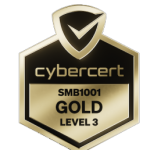### ISO/IEC 27001:2022 – A Comprehensive Framework for Information Security Management
#### Overview
The ISO/IEC 27001:2022 is the premier international standard for information security management systems (ISMS). Published by the International Organization for Standardization (ISO) and the International Electrotechnical Commission (IEC), this framework outlines a systematic approach to managing company and customer information based on ongoing risk assessment. The standard is designed to bring information security under explicit management control, ensuring confidentiality, integrity, and availability of data. Its purpose is to help organisations safeguard their information assets, thus enhancing consumer trust and business resilience. The primary audience for ISO/IEC 27001:2022 includes Chief Information Security Officers (CISOs), security professionals, IT managers, and anyone involved in or responsible for an organisation’s information security.
#### Key Components/Pillars
The framework’s structure is built around the following main components:
1. **Risk Management**: Identifying, analysing, and processing risks to ensure that they are within the organisation’s risk tolerance.
2. **Security Policy**: Defining a security policy that serves as a guideline for all infosec related activities.
3. **Organisation of Information Security**: Structuring and allocating responsibilities to ensure control over information security.
4. **Asset Management**: Identifying information assets and providing appropriate levels of protection.
5. **Human Resources Security**: Implementing pre- and post-employment policies and procedures to reduce risks of human error, theft, fraud or misuse of facilities.
6. **Physical and Environmental Security**: Protecting the physical premises and the environments where information is processed.
7. **Communications and Operations Management**: Managing technical and operational issues to ensure secure and effective operation of information.
8. **Access Control**: Limiting access to information and information processing facilities.
9. **Information Systems Acquisition, Development, and Maintenance**: Ensuring that security is an integral part of information systems.
10. **Information Security Incident Management**: Preparing for and managing information security breaches.
11. **Business Continuity Management**: Protecting, maintaining, and recovering business-critical processes and systems.
12. **Compliance**: Ensuring conformance with information security policies, standards, laws, and regulations.
#### Guidelines/Controls
For each security domain, the ISO/IEC 27001:2022 provides detailed guidance and controls:
– **Governance and Risk Management**: Establishes a systematic process to manage risks to information assets.
– **Personnel Security**: Outlines security protocols from hiring to termination, ensuring employees understand their responsibilities.
– **Physical Security**: Protects the physical premises and the equipment from unauthorised access and environmental hazards.
– **System Hardening and Configuration**: Guides the establishment of secure configurations for information systems and technology.
– **Access Control**: Details protocols to ensure only authorized individuals have access to systems and information.
– **Cryptography**: Provides guidance on the use and management of cryptographic controls.
– **Incident Response**: Outlines the framework for managing information security incidents and improvements post-incident.
#### Implementation and Compliance
The framework advocates a risk-based approach to implementation and compliance, prioritizing resources to areas of greatest risk. Organisations are encouraged to achieve certification to demonstrate that their ISMS meets international standards, through a systematic process involving internal audits, reviews, and a final certification audit from an accredited body.
#### Additional Resources
The ISO/IEC provides a range of supplementary resources, including advisories, alerts, and training programs, to support organisations in implementing the framework. Further information and guidance can be found on the official ISO website: [ISO/IEC 27001:2022 resources](https://www.iso.org/standard/54534.html).
#### Benefits and Adoption
Adopting ISO/IEC 27001:2022 offers organisations numerous benefits, including improved reputation, enhanced trust from customers and suppliers, compliance with legal and regulatory requirements, and a structured approach to cybersecurity risk management. Notably, various sectors globally, including finance, healthcare, and public services, have mandated or adopted the framework to protect against evolving cybersecurity threats.
In essence, ISO/IEC 27001:2022 provides a robust methodology for organisations aiming to secure their information assets comprehensively. Its widespread adoption attests to its effectiveness in building secure and resilient informational practices.

